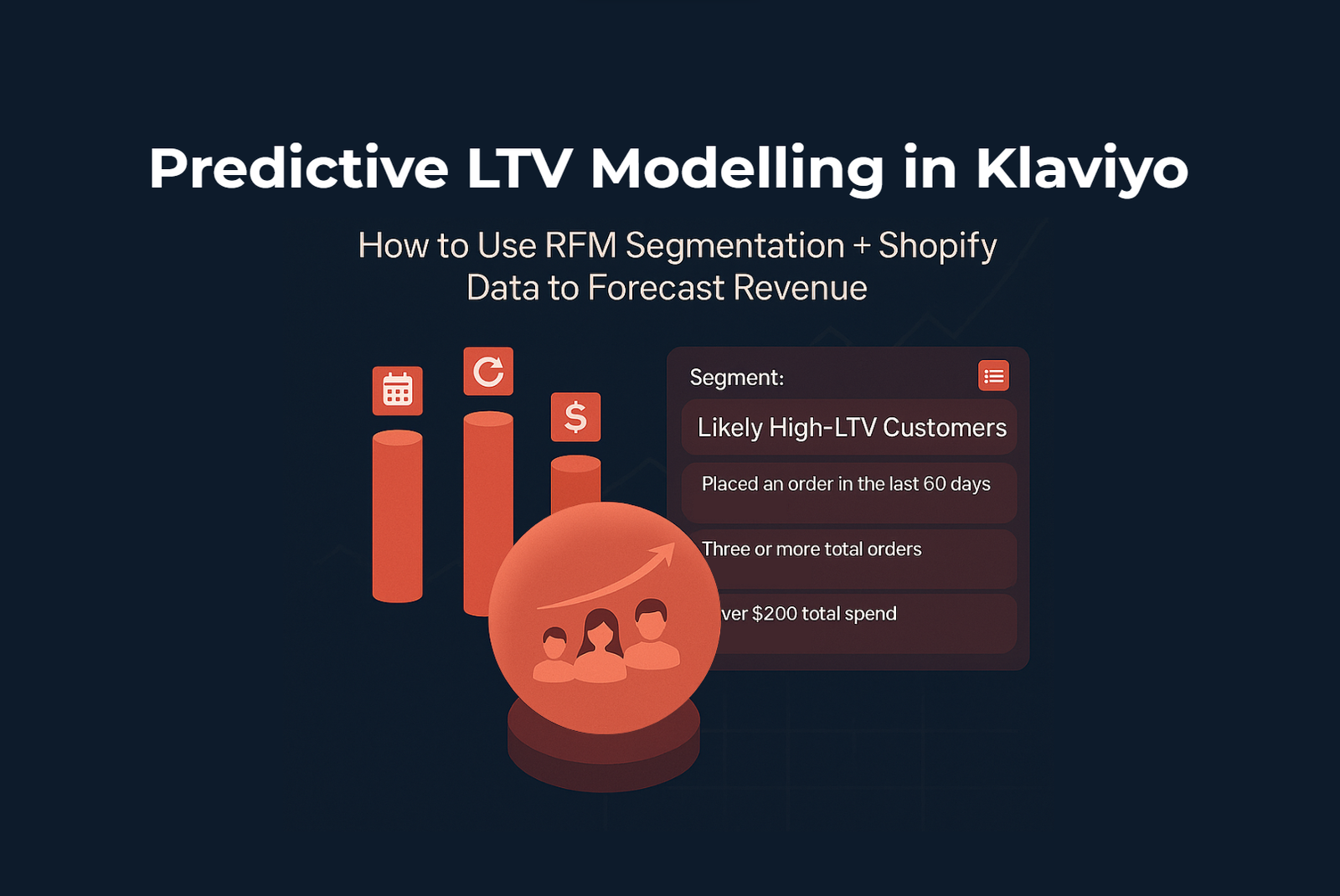Predictive LTV Modeling in Klaviyo: How to Use RFM Segmentation + Shopify Data to Forecast Revenue

Introduction: Why Predictive LTV Should Be on Every Brand’s Radar
Retention isn't just about keeping customers. It’s about understanding which customers are most valuable over time.
In 2025, brands that win are those who can predict customer lifetime value (LTV) instead of just reporting it after the fact. When predictive LTV is combined with RFM segmentation and Shopify data, Klaviyo becomes more than an email platform. It becomes a decision-making engine.
In this article, we’ll break down how to build predictive LTV models inside Klaviyo using RFM (Recency, Frequency, Monetary) segmentation and enriched Shopify purchase behavior. You’ll walk away with a clear, step-by-step framework for segmenting high-value customers, forecasting revenue, and powering smarter retention campaigns.
The Shift from Reactive to Predictive Retention
Most brands are reactive. They look at past revenue and try to reverse-engineer success. But forward-thinking operators ask better questions:
- What is this customer worth in 3, 6, or 12 months?
- How likely are they to return?
- What’s the best way to retain them before they churn?
This is where predictive LTV modeling and RFM come in. By analyzing how recently, how often, and how much customers purchase, you can project their future value and treat them accordingly.
Step 1: Connect the Right Data Klaviyo + Shopify
Before modeling anything, make sure Klaviyo is fully synced with Shopify.
You’ll need:
- Historical order data (product, date, revenue)
- Customer profiles with purchase timelines
- Lifetime spend per customer
Klaviyo automatically pulls this in from Shopify, but make sure your setup is tracking:
- First and last purchase dates
- Total revenue
- Number of orders per customer
Once synced, you’re ready to build smarter segments.
Step 2: Apply RFM Segmentation Logic
RFM (Recency, Frequency, Monetary) is a proven framework for understanding customer quality.
Here’s how to interpret it:
- Recency: How recently did the customer buy?
More recent means more likely to buy again. - Frequency: How often do they buy?
Frequent buyers show strong retention signals. - Monetary: How much have they spent?
Higher spenders show greater long-term value.
You can create these segments manually or use Klaviyo’s Custom Properties feature to assign RFM scores based on:
- Days since last order
- Number of orders
- Total revenue
Step 3: Build Predictive Segments in Klaviyo
Once you’ve grouped customers into RFM tiers, you can model future value by layering logic on top.
Example segment: Likely High-LTV Customers
- Placed an order in the last 60 days (Recency)
- Three or more total orders (Frequency)
- Over $200 total spend (Monetary)
You can go further by combining:
- Product preferences
- Time between purchases
- Device type or location (if relevant)
By comparing LTV trajectories of similar past customers, you can start forecasting with more confidence.
Step 4: Forecast LTV Using Cohort Patterns
Now that you have predictive segments, use historical cohort behavior to project future revenue.
For example:
- Customers in your "3 orders, $200 spend" segment, how much did past customers with those traits go on to spend?
- At what intervals did they return?
This turns your Klaviyo and Shopify data into a forecasting machine, not just a tracking tool.
You can even export segments to tools like Google Sheets or Looker Studio to visualize LTV curves.
Step 5: Activate with Lifecycle Automations
Prediction means nothing without execution.
Use your LTV segments to:
- Trigger VIP nurturing flows
- Prioritize winback campaigns by projected loss
- A/B test incentives for high versus low LTV customers
Even your campaign calendar can shift based on predicted value, driving stronger ROI per send.
Common Mistakes to Avoid
- Treating all repeat buyers the same
Not all frequent buyers are equal in value. - Relying only on Klaviyo's built-in Predicted CLV
It’s a good start, but customizing RFM tiers gives you sharper insight. - Ignoring timing patterns
If a high-value customer usually buys every 30 days and you don’t re-engage by day 25, you’re late.
Retention Is Predictive When You Build It Right
Predictive LTV modeling isn’t just a technical trick. It’s a strategic unlock.
When you combine RFM segmentation with real purchase behavior, your Klaviyo account becomes a source of truth for where future revenue lives and how to capture it.
Looking to turn your customer data into long-term revenue?
Let our team at Wertec help you engineer a predictive retention model that fits your business.